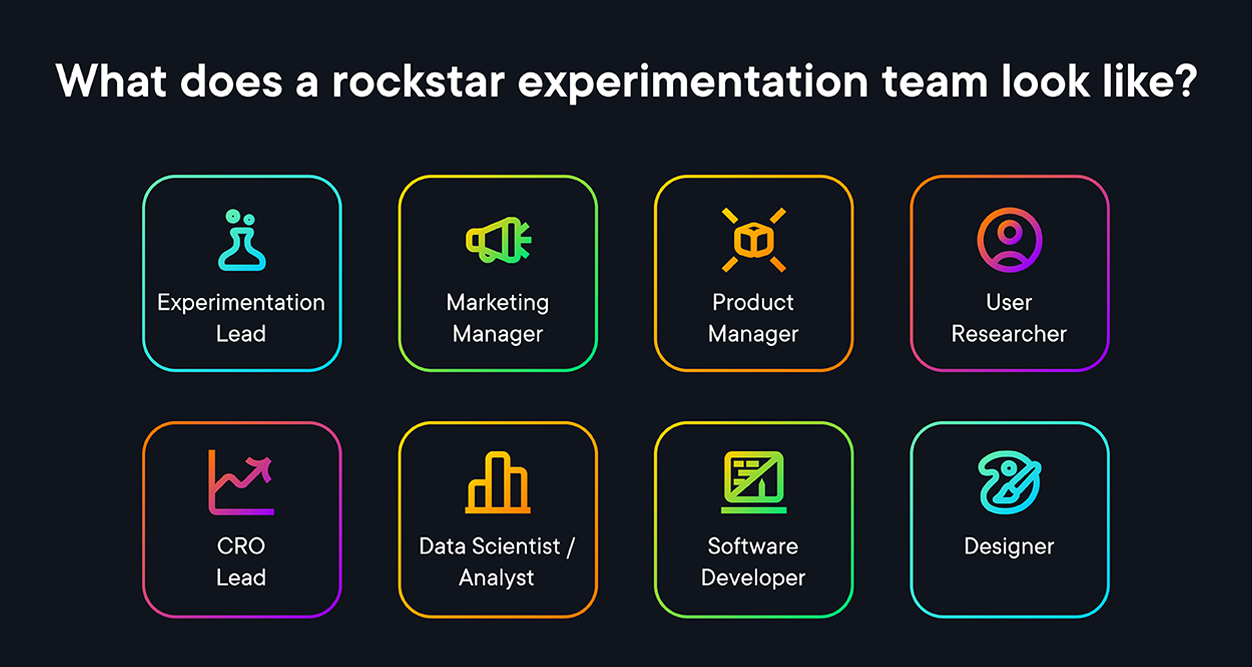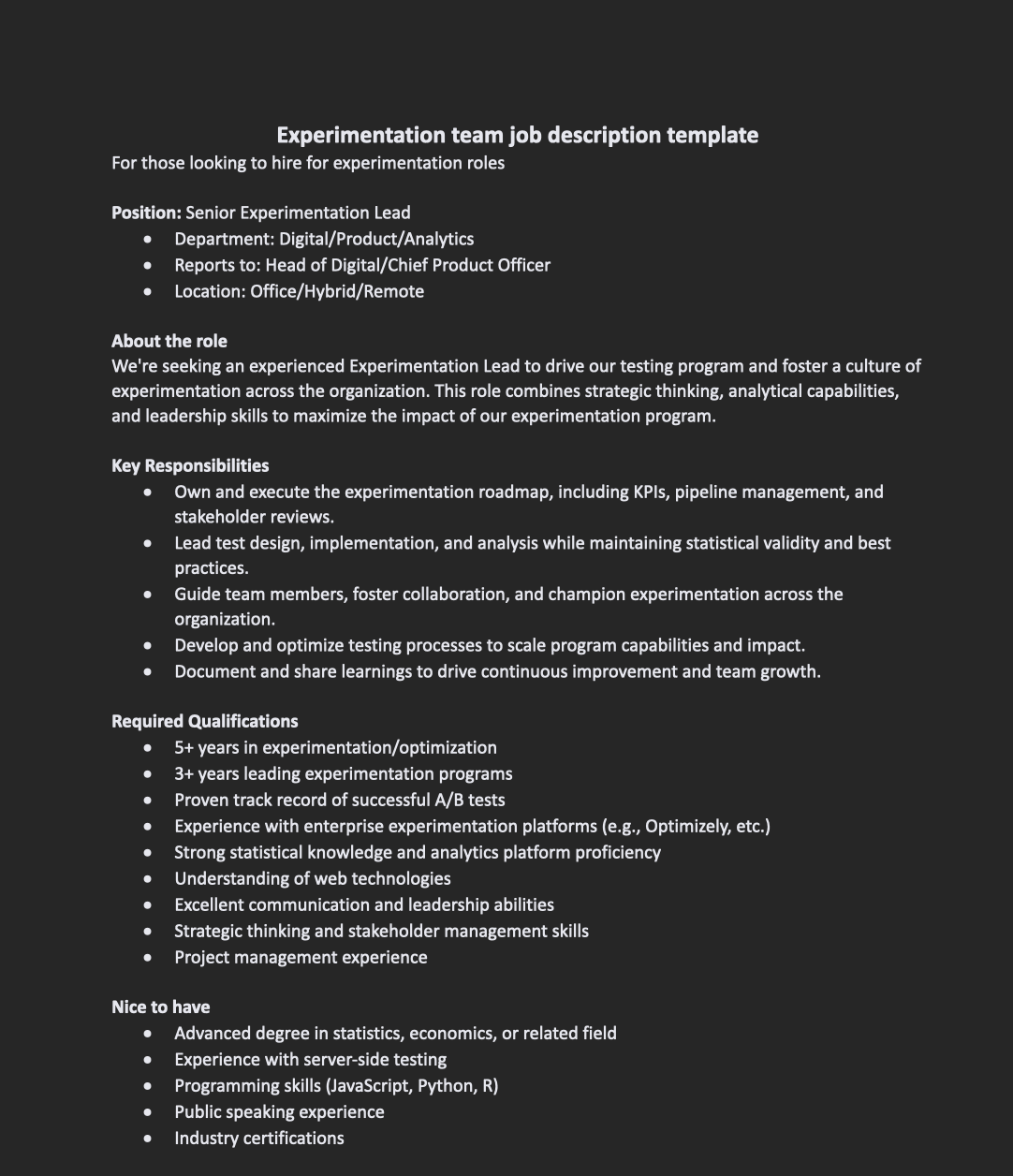The leader’s guide to building and retaining a rockstar experimentation team
Experimentation requires a blend of analytical thinking, creative problem-solving, and technical expertise. See how to hire, structure, and retain top talent.


Tools alone don't drive successful experimentation programs, people do.
The team you build can make or break your program's success. Just look at companies like Amazon, Netflix, and Booking.com. They don't simply "do CRO." They've built entire operations around experimentation as a core business function.
But finding the right talent with the necessary skillset isn't straightforward, even in today's job market. Why? Because experimentation requires a unique blend of analytical thinking, creative problem-solving, and technical expertise. It's a combination that's rare to find in a single individual and complex to build in a team.
The true cost of getting it wrong
Before we dive into how to build your dream team, let's talk about what happens when you don't get it right. A poorly structured experimentation team can lead to:
- Stagnant program growth: Your experimentation velocity stays low, and wins become increasingly hard to find.
- Siloed operations: Instead of fostering a culture of experimentation, you end up with disconnected departments running isolated tests.
- Lack of executive buy-in: Without proper communication and demonstrated value, leadership support wanes.
- Resource drain: The cost of hiring, training, and replacing the wrong talent quickly increases.
- Missed opportunities: While you're struggling with team issues, your competitors are racing ahead with data-driven decisions.
The good news? You don't need to hire an army to get started.
Building the right experimentation team isn't just about hiring people with technical skills – it's about finding individuals who can balance analytical rigor with creative problem-solving, who understand that every test is an opportunity to learn, and who can translate data into business impact.
This guide will show you exactly what to prioritize and when to do it.
What are the key roles and responsibilities for an experimentation team
Great teams don't start fully formed. In fact, at the beginning, all these different roles might be played by one passionate person!
The key is understanding the core functions needed and building towards them strategically.

The 8 core functions of experimentation teams:
-
Experimentation lead
- Owns the overall program strategy and roadmap
- Champions experimentation across the organization
- Drives test prioritization and resource allocation
- Builds and maintains stakeholder relationships
- Fosters a culture of experimentation
-
Marketing manager
- Brings customer journey expertise
- Identifies conversion opportunities
- Ensures brand consistency
- Translates test results into marketing strategies
- Aligns experiments with marketing campaigns
-
Product manager
- Aligns experiments with product roadmap
- Balances experimentation with feature development
- Ensures technical feasibility
- Translates wins into product improvements
- Prioritizes product-led experiments
-
User researcher
- Conducts qualitative research
- Identifies user pain points and opportunities
- Validates test hypotheses with user insights
- Provides context to quantitative data
- Leads user interviews and usability testing
-
CRO lead
- Develops test hypotheses
- Manages test execution
- Analyzes test results
- Documents learnings and insights
- Builds optimization roadmaps
-
Data scientist/analyst
- Owns test design and statistical validity
- Performs advanced data analysis
- Builds measurement frameworks
- Validates test results
- Identifies opportunities through data mining
-
Software developer
- Implements A/B tests
- Ensures technical quality
- Manages test QA process
- Handles technical documentation
- Supports server-side testing needs
-
Designer
- Creates test variations
- Ensures consistent user experience
- Provides visual solutions
- Maintains design systems
- Collaborates on prototypes
You don't need all eight roles filled immediately. Start with the most critical functions for your business and expand as your program matures and proves its value.
How are our customers approaching this?
A couple of our customers share what their experimentation teams look like:
- Tapestry's approach to building their experimentation team
- How DocuSign structured their program for success
How can I determine the best team structure for my organization
The different skills required fall roughly into two categories: Your must-have skills and nice-to-have skills.
The foundation: Your must-have skills
Part 1: Analytics and research
Statistics
- Why: Because an experiment is statistics
- What you need: Someone who can understand sample size calculation, statistical significance, and different testing models (Bayesian, Sequential, Frequentist)
- No PhD required, but someone needs to own this. Companies are specifically asking for a "good understanding of different statistical models" in 2024 job posts.
Digital analytics
- Essential tools: Google Analytics, Heatmapping, Session recording
- Must be able to process data, build hypotheses, and turn them into actual insights
- Analysis without insights is just pretty charts. Tools are teachable, insight generation is a skill. Hire for the latter.
User testing and research
- Numbers tell what, and research tells why. Understand the 'why' behind user behavior
- Key capabilities: User interview skills. Qualitative data analysis. Problem identification.
- This can be done by the same person doing analytics (to start)
Test + Learn: Experimentation
Part 2: Design and creative
UX design (Basic level)
- Wireframing skills, user flow mapping, and basic prototyping
- Focus on modifying existing experiences
- You don't need full visual design skills (yet)
Copywriting
- Why it's crucial: Copy changes = big impact
- Priority: Understanding conversion psychology and value proposition crafting
Part 3: Development
Front-end development
- Must-have: HTML, CSS, JavaScript skills
- Other requirements: Experimentation tools expertise and QA capabilities
- Experience with enterprise tools like Optimizely and understanding of implementation methods
Project management is the glue
- Doesn't need to be a certified PM
- Must be someone who can own test pipeline management, stakeholder communication, and process optimization
- Can be your CRO specialist wearing multiple hats
Nice-to-have skills (For later)
Part 1: Analytics and research EXTRAS
Psychology and behavioral economics
- For: Advanced user understanding
- When: Once the basic testing program is solid
Data programming
- Think: SQL, Python
- When: When basic analytics tools limit you
Design thinking
- For: Expanding beyond website testing
- When: Ready for organization-wide experimentation
Part 2: Design and creative EXTRAS
Visual design
- For: Creating entirely new experiences
- When: Moving beyond modification testing
Customer experience design
- For: Broader business experimentation
- When: Ready to expand beyond digital
Part 3: Development EXTRAS
Back-end development
- For: Server-side testing
- When: Ready for complex experiments
Technology implementation
- For: Advanced tracking and tagging
- When: Basic implementation limits growth
Choosing your team structure
As your program grows, you'll need to decide between different organizational models.
A Center of Excellence (CoE) brings standardized methodologies, concentrated expertise, and efficient resource use – but can become a bottleneck as programs grow.
Meanwhile, decentralized teams offer faster execution and closer alignment with product teams, though maintaining consistency becomes challenging. Many successful organizations find their sweet spot in a hybrid approach. Starting centralized to build strong foundations, then gradually decentralizing as their experimentation culture matures.
What are the essential qualities to look for when hiring for an experimentation team?
With your team structure defined, the next challenge is finding the right talent. Here's what leading companies are looking for in their experimentation hires today.
Just landed... An experimentation lead job description that perfectly illustrates what companies want now

Get the free experiment lead job description template that also includes success metrics and interview question suggestions.
Finding and retaining experimentation talent
Here's where to look and how to keep your team engaged.
Where to find great talent:
-
Industry events and conferences
- Opticon
- Marketing analytics summit
- Local experimentation meetups
-
Specialized communities
- Experiment Nation
- Women in experimentation
- CRO/Experimentation slack groups and regional testing communities
-
Dedicated job boards
However, the cost of losing great experimentation talent isn't just financial. It can set your program back months.
So, once you've hired your team, here's how to retain it.
Here's how to keep your team engaged:
-
Create growth opportunities
- Clear career progression paths
- Industry certification support
- Leadership development programs
-
Invest in programs
- Access to advanced tools and platforms
- Training and development budget
- Team knowledge-sharing sessions
-
Promote culture and recognition
- Celebrate test learnings (not just wins)
- Share success stories company-wide
- Regular team retrospectives
Tip: Create a culture of experimentation where failure is seen as learning. Teams that feel safe to experiment and learn tend to stay longer and produce better results. Through consistent knowledge sharing and celebration of both successes and learnings, teams naturally become more experimental in their approach. While this transformation takes time, the impact on innovation and decision-making makes it worth the investment.
Whether you're building from scratch or scaling an existing program, focus on getting the foundations right first. Start with essential skills, build your core team thoughtfully, and grow your program systematically.
Ready for experimentation success?
Building an experimentation team is about creating a squad that turns "we should probably test that" into "holy data, look at these insights!"
When you get the team right, magic happens. Your analytics folks turn numbers into narratives, your developers make testing look like an art form, and your researchers uncover insights that make everyone go "Why didn't we think of that before?!"
Sure, there might be a few bumps along the way (finding a developer who actually enjoys A/B testing is difficult as they mostly use testing tools as code editors), but with the right people in place, you'll wonder how you ever made decisions without them.
After all, experimentation isn't just about running tests – it's about building a culture where curiosity rules, data leads the way, and "because we've always done it that way" gets shown the door.
If you're ready to take your experimentation program to the next level, explore our analysis of 127k experiments. It’s packed with insights to help you build and scale your team for maximum impact.
![]()

